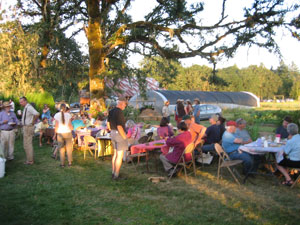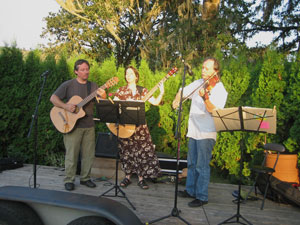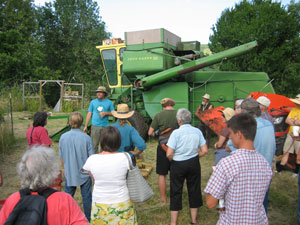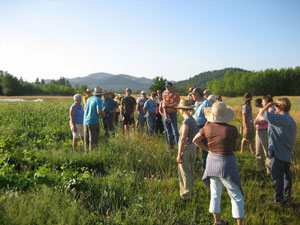

Home | Spaceship Earth | Book Reviews | Buy a Book | Bean and Grain Index | Short Stories | Contact | Mud Blog
Open Oak Farm, a second-year, 30-acre farm, owned and operated by three young farmers, Sarah Kleeger, Andrew Still, and Cooper Boydston, hosted a Bean and Grain Project farm tour on August 4. Open Oak is also home to Sarah and Andrew's Adaptive Seeds Company, so along with providing product for their bean, grain, and winter vegetable CSA, Open Oak gives Sarah and Andrew, both well-known for their work in the Seed Ambassadors Project, the space to grow out the seed they've collected during their world travels and to build the inventory of their seed company. At any one time, theyïll have more than 400 different varieties of beans, grains, and vegetables on the farm either in the ground or as starts.
The weather cooled off from the high 80s earlier in the week to the low 80s with just enough cloud cover to make for a very pleasant afternoon and evening. The event was a potluck dinner as well as a tour and the first of 150 guests began to roll down the Open Oak driveway about a quarter to four with various dishes prepared from local sources. At five-thirty, Chico Schwall arrived with his string-band. Add a keg of Line Dry Rye Ale from Oakshire Brewing Company and suddenly the farm scene began to look a whole lot like a party.
While the music played and the guests delved into a remarkable spread of food and beverages, Andrew Still began the first of what would be three separate tours of the farm–one by each Andrew, Sarah, and Cooper. With the eager to learn guests and Andrew's encyclopedic knowledge of beans, grains, and seed given free rein, this first tour lasted two hours and was more like a graduate field course in farming and farm machinery than a simple meander through 30-acres of mixed crops.


It's true that quite a bit of the variety at Open Oak is in vegetables, both for product and seed, however, even a short list of the grains and legumes growing on the farm gives one an idea of what Open Oak is about–several varieties of barley (including Ethiopian, Bavarian, and purple), flax, peas, more varieties of wheat than you can name, triticale, orca beans, rio zape beans, yellow-eye beans, hutterite beans, oats, hulless oat, Saskatoon flint corn–for grits, Roy's callas flint corn, Maine sweet corn for polenta, buckwheat, and several varieties of rye.
One nice addition to Andrew's tour was that it included Harry MacCormack from Sunbow Farm, who was making his first visit to Open Oak. As members of the Bean and Grain Project Harry and Andrew have been talking beans and grains for five years now and getting them together in the field made for a very elevated discourse. For the others in the tour, it meant that there was no question that couldn't be answered–often from more than one perspective.


During the tour, several interesting insights were pointed out by Andrew–and often seconded by Harry. One crop that has been adopted by almost all the bean and grain growers in the valley is buckwheat. Andrew noted that buckwheat is referred to as a phosphorus "pump." This means it has the capacity to seek out and integrate phosphorous in its organic matter. This capacity makes it an excellent green manure and rotation crop. Legumes can fix nitrogen. Buckwheat can store phosphorus.
Another topic of debate over the last few years has been the water needs of the dry-land beans. While garbanzo beans have been successfully grown with little or no irrigation, some of the other bean varieties like the black, pinto, and orca have struggled during late summer when the weather gets particularly hot and dry. Andrew told the tour guests that he believed those beans could survive without water but did best when irrigated two to three times during the summer. Underlining this point, he referred to water as the cheapest form of fertilizer.
Of the wheat varieties on display at Open Oak, Andrew spoke at length about a very old variety called Maris Widgeon that he'd obtained from a "seed archeologist" he and Sarah met in England. This man would literally seek out seed in the thatching of old homes in the English countryside and grow it out. The Maris Widgeon was one of these thatching varieties and seemed to be growing quite well at Open Oak. It stood out as a winter wheat this year because it did not get stripe rust. Stripe rust is always a concern for wheat growers in western Oregon and with the wet spring, it hit the valley hard this growing season. For conventional wheat, stripe rust is generally combated by an anti-fungicide sprayed from the air, but this practice can not be used on organic wheat. Finding stripe rust resistance wheat varieties and maintaining them is a huge aid to organic wheat growers in the Willamette Valley.
As said earlier, the expansion of varieties, the cultivation of large numbers of test plots, and the collection of seed are absolutely necessary to advance the long-term intentions of the Bean and Grain Project. The innovative work of Andrew, Sarah, and Cooper at Open Oak Farm can not be undervalued–not to mention what it does for the variety in their beans, grains, and winter vegetable CSA.
_______________
Go to Stalford Seed Farms Tour.
Special thanks is extended to The Willamette Farm and Food Coalition and The Ten Rivers Food Web, Hummingbird Wholesale, and the Evergreen Hill Fund of Oregon Community Foundation for for their continued support of the Southern Willamette Valley Bean and Grain Project.